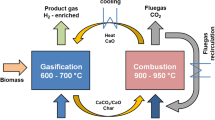Abstract
The classical route for iron- and steel-making today is based on massive use of fossil coal, which is responsible for most of the large CO2 emissions of the steel industry. Biomass, as a renewable carbon resource, is a good candidate to substitute for fossil coal and even partial substitution could lead to a significant reduction in CO2 emissions. Depending on the type of biomass, its processing, and the way it is used in the iron making process, many different scenarios may be considered. Those scenarios should be evaluated and compared from technical, environmental, and economical points of view in order to figure out the best options. The case of a real pig iron plant located in the North East of France was investigated. First, we checked the relevance of various biomass options on the basis of the biomass availability around the plant and of the technical requirements of the processes. Then, we carried out a screening life cycle assessment focusing on global warming impacts and following a cradle-to-gate approach. Different biomass-based pig iron production scenarios were compared. The results showed that for a 20 % substitution of biomass for coke, around 300 kg of CO2-equivalent per ton of pig iron produced could be saved, which represents a reduction of 15 % in the total greenhouse gas emissions. Finally, a brief economic evaluation of the resulting scenarios was performed.





Similar content being viewed by others
References
IEA: Sectoral Approaches to Greenhouse Gas Mitigation—Exploring Issues for Heavy Industry. International Energy Agency, Paris (2007)
European Commission: 2007/589/EC: Commission Decision of 18 July 2007 Establishing Guidelines for the Monitoring and Reporting of Greenhouse Gas Emissions Pursuant to Directive. Off J Eur Union (2007)
Norgate, T.E., Langberg, D.: Environmental and economic aspects of charcoal use in steelmaking. ISIJ Int. 49(4), 587–595 (2009)
Wing, Ng K., Giroux, L., MacPhee, T., Todoschuk, T.: Combustibility of charcoal for direct injection in blast furnace ironmaking. Assoc. Iron Steel Technol. (2012)
Mathieson, J.G., Rogers, H., Somerville, M.A., Jahanshahi, S., Ridgeway, P.: Potential for the use of biomass in the iron and steel industrie. In: Chemeca 2011, Syndey, Australia, 18–21 Sept 2011
Matsumura, T., Ichida, M., Nagasaka, T., Kato, K.: Carbonization behaviour of woody biomass and resulting metallurgical coke properties. ISIJ Int. 48(5), 572–577 (2008)
Macphee, J.A., Gransden, J.F., Giroux, L., Price, J.T.: Possible CO2 mitigation via addition of charcoal to coking coal blends. Fuel Process. Technol. 90, 16–20 (2009)
Lovel, R., Vining, K., Dell’Amico, M.: Iron ore sintering with charcoal. Miner. Process. Extr. Metal. 116(2), 85–92 (2007)
Lovel, R., Vining, K., Dell’Amico, M.: The influence of fuel reactivity on iron ore sintering. ISIJ Int. 49(2), 195–202 (2009)
Guivarch A.: Valeur Fertilisante à Court Terme du Phosphore des Boues de Stations D’épuration Urbaines. INPL (2001)
Leclerc, M.C.: Canne de maïs ensilée. L’institut de l’élevage (2003)
US Department of Energy: Biomass Feedstock Composition and Property Database. http://www1.eere.energy.gov/biomass/databases.html (2004)
Mohan, D., Pittman, C.U., Steele, P.H.: Pyrolysis of wood/biomass for bio-oil: a critical review. Energy Fuels 20, 848–889 (2006)
Bergman P.C.A., Boersma A.R., Kiel J.H.A., Prins M.J., Ptasinski K.J., Janssen, F.J.J.G.: Torrefaction for biomass upgrading. In: European Biomass Conference & Exhibition, Paris, France, 17–21 Oct 2005
Norgate, T., Haque, N., Somerville, M.A., Jahanshahi, S.: Biomass as a source of renewable carbon for iron and steelmaking. ISIJ Int. 52(8), 1472–1481 (2012)
European Parliament: Les forêts de l’union européenne. http://www.europarl.europa.eu/workingpapers/agri/s4-1-1_fr.htm (1996)
Agreste, Ministère de l’agriculture de l’alimentation de la pêche de la ruralité et de l’aménagement du territoire: Récolte de bois et production de sciages en 2008. Agreste Chiffres et Données Agroalimentaires 170 (2010)
Palosuo, T., Wihersaari, M., Liski, J.: Net greenhousegas emissions due to energy use of forest residues—Impact of soil carbon balance. In: Woody Biomass as an Energy Source—Challenges in Europe, Joensuu, Finland, 25–28 Sept 2000
ADEME: La récolte raisonnée des rémanents en forêt (2008)
IFN, ADEME, Solagro: Evaluation du potentiel Bois Energie (2004)
Renaud, J.P.: Innovations dans la gestion des marchés: les contrats d’approvisionnement. In: Forêt-bois: quelles ressources pour quels produits? Nancy 2011
ADEME, ITCF: Résidus de culture: paille de céréales. ADEME, ITCF, Paris (1998)
Sourie, J.C.: Les pailles de céréales, ressources, valorisations, obstacles à leur mobilisation. In: Chimie verte: questions à la recherche, Paris 2006
Raffelt, K., Henrich, E., Koegel, A., Stahl, A., Steinhardt, J., Weirich, F.: The BTL2 process of biomass utilization entrained-flow gasification of pyrolyzed biomass slurries. Appl. Biochem. Biotechnol. 129, 153–164 (2006)
CAL: Agriculture en Lorraine. http://cra-lorraine.fr/index.php?page=060&rubrique=Productions%20agricoles (2010)
Guillin, S.: Les grandes cultures en Lorraine—Récolte 2011. DRAAF, Metz (2011)
Agreste: Déchets des industries agroalimentaires selon le type de déchet et la région en 2008. Agreste Primeur, vol. 245. Agreste Primeur (2010)
Agreste, I.N.S.E.E.: Enquête sur la production de déchets non dangereux dans l’industrie en 2008. Agreste, Montreuil sous bois (2010)
FAO: FAOSTAT (2012)
Börjesson, P.I.I.: Emissions of CO2 from biomass production and transportation in agriculture and forestry. ECM 37(6–8), 1235–1240 (1996)
Pennise, D.M., Smith, K.R., Kithinji, J.P., Rezende, M.E., Raad, T.J., Zhang, J., Fan, C.: Emissions of greenhouse gases and other airborne pollutants from charcoal making in Kenya and Brazil. JGR 106(24), 143–155 (2001)
Hammond, J., Shackley, S., Sohi, S., Brownsort, P.: Prospective life cycle carbon abatement for pyrolysis biochar systems in the UK. Energy Policy 39, 2646–2655 (2011)
Steelonthenet: Metallurigcal coke prices—Europe 2008–2012. http://www.steelonthenet.com/files/blast-furnace-coke.html (2012). Accessed 27 Apr 2012
Acknowledgments
The authors thank Saint-Gobain PAM and Agence Nationale de la Recherche et de la Technologie for their financial support.
Author information
Authors and Affiliations
Corresponding author
Rights and permissions
About this article
Cite this article
Fick, G., Mirgaux, O., Neau, P. et al. Using Biomass for Pig Iron Production: A Technical, Environmental and Economical Assessment. Waste Biomass Valor 5, 43–55 (2014). https://doi.org/10.1007/s12649-013-9223-1
Received:
Accepted:
Published:
Issue Date:
DOI: https://doi.org/10.1007/s12649-013-9223-1




